[it]Ciao ragazzi,
oggi affrontiamo un argomento particolare, ovvero la fusione di foto HDR con foto normali. Come ben sapete l’HDR è una tecnica che prevede l’utilizzo di 3 o più fotografie (sottoesposte, sovraesposte ed esposte normalmente) che unite sono in grado di dare un’immagine in cui si ha dettaglio sia nelle zone d’ombra che in quelle di luce. Per chi volesse saperne un po’ di più sull’HDR avevo scritto un articolo tempo fa, lo trovate al seguente link https://www.stefanotealdi.com/2010/hdr-vs-layering. Capite bene che è impossibile applicare l’HDR a foto in cui ci sia anche un soggetto umano perchè questo, per quanto possiamo fare velocemente i tre o più scatti tramite il bracketing della macchina fotografica, si muoverà. Il movimento può anche essere impercettibile ad occhio, ma nel momento in cui andiamo ad unire le foto con un programma che generi l’HDR si vedrà perfettamente la differenza di pochi pixel tra una posizione e l’altra.
Pertanto se si vuole avere un soggetto in una foto HDR è necessario realizzare prima il background, e poi in postproduzione inserire il soggetto. Vediamo innanzitutto il background che ho scelto per la mia foto. Si tratta di una struttura abbandonata che ho trovato dove non si può entrare (e in più penso sia parecchio pericoloso entrare a causa di cedimenti..), ma dove ho potuto infilare la mia reflex su treppiede per realizzare i 5 scatti necessari per la realizzazione dell’HDR. Trovate qui di seguito i 5 scatti (-2EV, -1EV. 0EV, +1EV, +2EV) e il risultante HDR:[/it][en]Hi guys!
today we explore a particular topic, i.e. the fusion of an HDR photo with a normal one. As you weel know the HDR is a tecnique which needs the use of 3 or more shots (overexposed, normally exposed, underexposed) in order to create an image which has detail both in the shadows and in the lights. For whom wants to know a little more about HDR I had written an article some time ago, which you can find here https://www.stefanotealdi.com/2010/hdr-vs-layering. You can easily understand which is impossible to apply the HDR to a shot with a human being inside because the person, even if we can do the three shots with the machine bracketing very fast, will move. The movement can be subtle, but that little movement will generate a lot of problems using the software which generates the HDR.
So in order to have a subject in a HDR photo it is necessary to realize first the background, and then position the subject in postproduction. Let’s see first of all the background I choose for my photo. It is an abandoned structure where you can’t enter (and it would be dangerous to enter..), but I could put my tripod inside it and realize the 5 shots necessary for the HDR. Hereafter you can find the 5 shots (-2EV, -1EV. 0EV, +1EV, +2EV) and the final HDR:[/en]
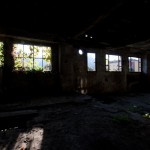 |
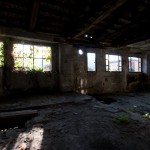 |
 |
 |
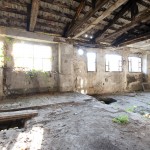 |
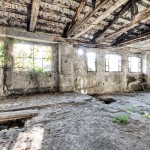 |
[it]A questo punto realizzato l’HDR dello sfondo è stato necessario scattare una foto al soggetto per poi inserirlo a posteriori. In questa fase è fondamentale capire da dove arriva la luce nella foto di background. Come potete vedere la luce arriva dalle finestre da dietro, pertanto il soggetto dovrà avere una rim light (o separation light), cioè una luce che ne definisce il contorno come se arrivasse dalle finestre poste dietro. Ma ovviamente se vogliamo che il soggetto sia ben illuminato dobbiamo avere anche una luce posta davanti che lo illumini, e quindi ho optato per un flash in un ombrellino. Purtroppo non avevo modelle a disposizione quindi mi spiace ma vi dovete accontentare e vedere me stesso, mi sono fatto un autoscatto :D[/it][en]At this point, having realized the HDR background, a shot of the subject came next. In this phase it is foundamental to understand where the light comes from in the background shot. In this case the light arrives from behind, so the subject must have a rim light (or separation light), in order to define his shape as a light would arrive from behind. But obviously if we want the subject to be well lightened we need a front light to lighten him, so I used a flash in an umbrella. Unfortunetely I did not have a model so you have to see me, with this autoshot :D[/en]
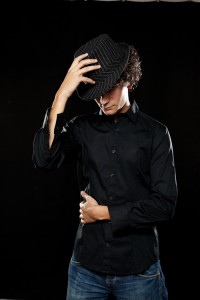 [it]Fatta la foto al soggetto su un fondo che sia facile da ritagliare in postproduzione, la cosa difficile è far sì che soggetto e sfondo si fondano bene insieme. Non è un’operazione facile, ma tramite l’uso di livelli di gestione del colore e l’uso di textures, è possibile ottenere un risultato simile.[/it][en]Did the shot to the subject easy to crop in postproduction, the difficult is to make him blend with the background. It is not simple, but using color management layers and textures, it is possible to obtain a similar result.[/en]
[it]Fatta la foto al soggetto su un fondo che sia facile da ritagliare in postproduzione, la cosa difficile è far sì che soggetto e sfondo si fondano bene insieme. Non è un’operazione facile, ma tramite l’uso di livelli di gestione del colore e l’uso di textures, è possibile ottenere un risultato simile.[/it][en]Did the shot to the subject easy to crop in postproduction, the difficult is to make him blend with the background. It is not simple, but using color management layers and textures, it is possible to obtain a similar result.[/en]
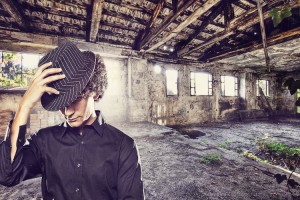 [it]Come potete notare ho modificato i colori di luci e ombre sia dello sfondo che del soggetto in maniera tale che si fondessero bene, e a quel punto aumentando ulteriormente la luce che arriva da dietro il gioco è fatto!!
[it]Come potete notare ho modificato i colori di luci e ombre sia dello sfondo che del soggetto in maniera tale che si fondessero bene, e a quel punto aumentando ulteriormente la luce che arriva da dietro il gioco è fatto!!
Adesso vi chiedo, vi siete mai cimentati in cose del genere? Qual è il composite più difficile che avete realizzato, e come ci siete riusciti? Potete scriverlo direttamente qui sotto e postare link ad immagini così da poterne discutere insieme!
Stefano[/it][en]As you can notice I modified the light and shadow colors both of the background and of the subject in order to make them blend, and at this point I made a greater light from behind in the windows!
Now I ask you, did you ever made something similar? Which is the most difficult composite you ever realized, and how did you made it? You can write in the comments section below and post links to the shots in order to discuss all together about it!
Stefano[/en]

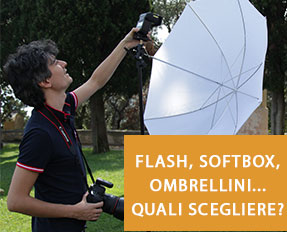
Per i meno esperti, se avessi fatto il bracketing con la persona sulla scena, poi come avresti fuso le varie foto per recuperare i troppo scuri e i troppo chiari ?
Video tutorial, magari utilizzando Gimp, in arrivo ?
Con persone non faccio il bracketing, al massimo faccio una foto al paesaggio in bracketing e una alla persona con il flash e poi monto tutto insieme in postproduzione..
Mi spiace ma non penso di fare video sulla postproduzione dato il mio basso livello su questo campo..